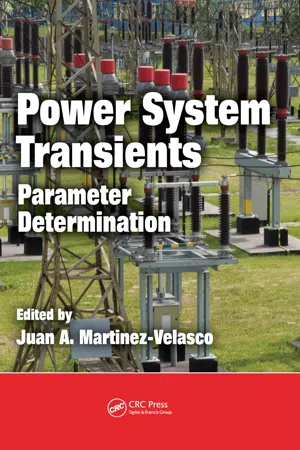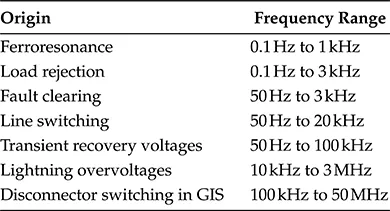
- 644 pages
- English
- ePUB (mobile friendly)
- Available on iOS & Android
About this book
Despite the powerful numerical techniques and graphical user interfaces available in present software tools for power system transients, a lack of reliable tests and conversion procedures generally makes determination of parameters the most challenging part of creating a model.
Illustrates Parameter Determination for Real-World Applications
Geared toward both students and professionals with at least some basic knowledge of electromagnetic transient analysis, Power System Transients: Parameter Determination summarizes current procedures and techniques for the determination of transient parameters for six basic power components: overhead line, insulated cable, transformer, synchronous machine, surge arrester, and circuit breaker. An expansion on papers published in the IEEE Transactions on Power Delivery, this text helps those using transient simulation tools (e.g., EMTP-like tools) to select the optimal determination method for their particular model, and it addresses commonly encountered problems, including:
- Lack of information
- Testing setups and measurements that are not recognized in international standards
- Insufficient studies to validate models, mainly those used in high-frequency transients
- Current built-in models that do not cover all requirements
Illustrated with case studies, this book provides modeling guidelines for the selection of adequate representations for main components. It discusses how to collect the information needed to obtain model parameters and also reviews procedures for deriving them. Appendices summarize updated techniques for identifying linear systems from frequency responses and review capabilities and limitations of simulation tools. Emphasizing standards, this book is a clear and concise presentation of key aspects in creating an adequate and reliable transient model.
Frequently asked questions
- Essential is ideal for learners and professionals who enjoy exploring a wide range of subjects. Access the Essential Library with 800,000+ trusted titles and best-sellers across business, personal growth, and the humanities. Includes unlimited reading time and Standard Read Aloud voice.
- Complete: Perfect for advanced learners and researchers needing full, unrestricted access. Unlock 1.4M+ books across hundreds of subjects, including academic and specialized titles. The Complete Plan also includes advanced features like Premium Read Aloud and Research Assistant.
Please note we cannot support devices running on iOS 13 and Android 7 or earlier. Learn more about using the app.
Information
1
Parameter Determination for Electromagnetic Transient Analysis in Power Systems
CONTENTS
1.1 Introduction

Procedure to obtain a complete representation of a power component. (From Martinez, J.A. et al., IEEE Power Energy Mag., 3, 16, 2005. With permission.)
- First, choose the mathematical model.
- Second, collect the information that could be useful to determine the values of parameters to be specified.
- Third, decide whether the available data are enough or not to derive all parameters.
1.2 Modeling Guidelines
- The document written by the CIGRE WG 33-02 covers the most important power components and proposes the representation of each component taking into account the frequency range of the transient phenomena to be simulated [2].
- The fourth part of the IEC standard 60071 (TR 60071-4) provides modeling guidelines for insulation coordination studies when using numerical simulation, e.g., EMTP-like tools [3].
- The documents produced by the Institute of Electrical and Electronics Engineers (IEEE) WG on modeling and analysis of system transients using digital programs and its task forces present modeling guidelines for several particular types of studies [4].
Origin and Frequency Ranges of Transients in Power Systems

Modeling of Power Components for Transient Simulations

- Select the system zone taking into account the frequency range of the transients; the higher the frequencies, the smaller the zone modeled.
- Minimize the part of the system to be represented. An increased number of components does not necessarily mean increased accuracy, since there could be a higher probability of insufficient or wrong modeling. In addition, a very detailed representation of a system will usually require longer simulation time.
- Implement an adequate representation of losses. Since their effect on maximum voltages and oscillation frequencies is limited, they do not play a critical role in many cases. There are, however, some cases (e.g., ferroresonance or capacitor bank switching) for which losses are critical to defining the magnitude of overvoltages.
- Consider an idealized representation of some components if the system to be simulated is too complex. Such representation will facilitate the edition of the data file and simplify the analysis of simulation results.
- Perform a sensitivity study if one or several parameters cannot be accurately determined. Results derived from such a sensitivity study will show what parameters are of concern.

Comparative modeling of lines: FD and CP models. (a) Scheme of the test case; (b) wave propogation along the line.

Field winding current in a synchronous generator during a three-phase short circuit. (a) Field current when coupling between the rotor d-axis circuits is assumed; (b) field current when coupling between the rotor d-axis circuits is neglected. (From Martinez, J.A. et al., IEEE Power Energy Mag., 3, 16, 2005. With permission.)
1.3 Parameter Determination
- Electr...
Table of contents
- Cover
- Half title
- Title Page
- Copyright Page
- Table of Contents
- Preface
- Editor
- Contributors
- 1. Parameter Determination for Electromagnetic Transient Analysis in Power Systems
- 2. Overhead Lines
- 3. Insulated Cables
- 4. Transformers
- 5. Synchronous Machines
- 6. Surge Arresters
- 7. Circuit Breakers
- Appendix A: Techniques for the Identification of a Linear System from Its Frequency Response Data
- Appendix B: Simulation Tools for Electromagnetic Transients in Power Systems
- Index